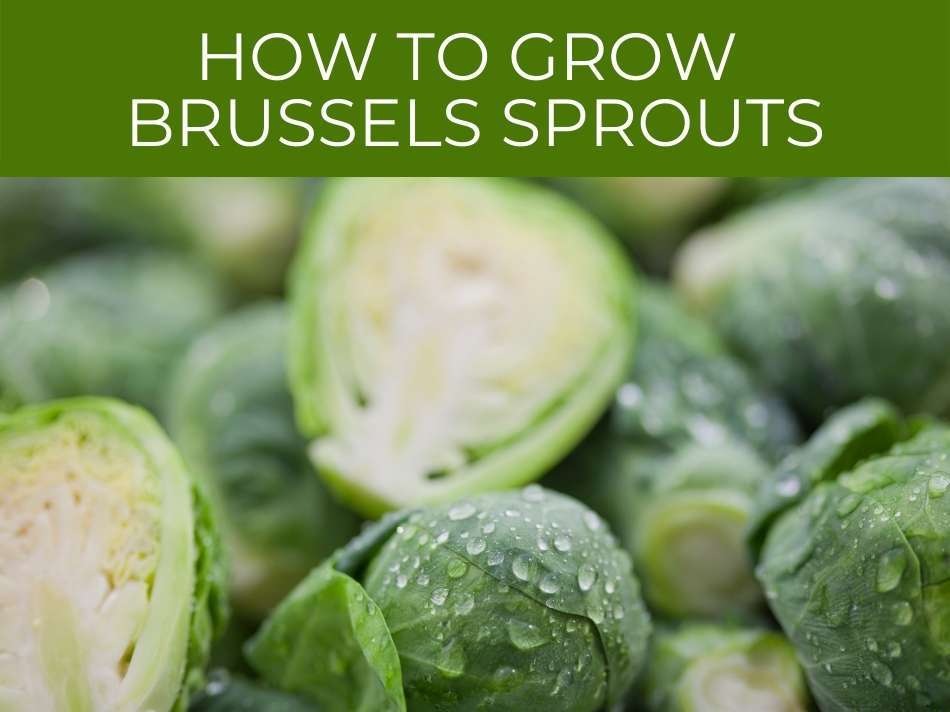Brussels sprouts have an undeserved reputation at the kitchen table, but are delicious, packed with health benefits. And for gardeners, Brussels sprouts are an easy-to-grow, low-maintenance plant.
Brussels sprouts take 80-90 days to harvest, so plant in mid-summer for a fall crop, or for an early summer crop, start seeds indoors 3-4 weeks before transplanting outdoors (6-8 weeks before last frost date). Space plants 18-24 inches apart, in full sun and rich soil. Harvest when sprouts are 1-2 inches in diameter.
It can be challenging to grow vegetables yourself, especially one with such a checkered dinnertime past. But you’ll be surprised at how versatile this oft-maligned vegetable is. From grilling to roasting, to yes, even boiling, there are easy ways to add Brussels sprouts to the dinner table. Ready to begin that process? Step into the garden and let’s get started!
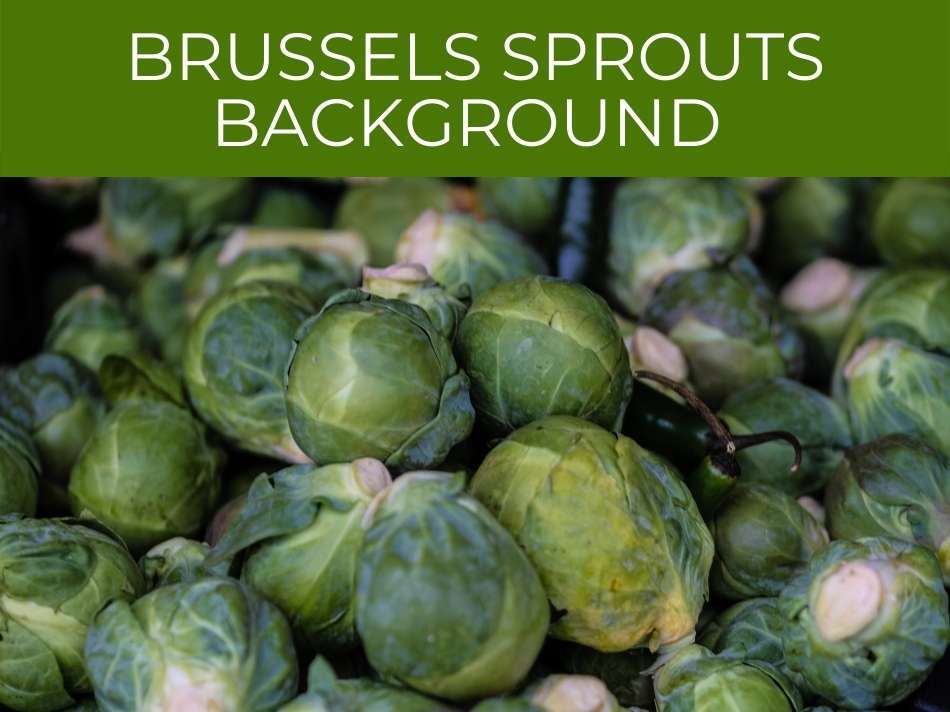
Brussels Sprouts Background
Before you start planting, it’s a good idea to learn a little bit about this unique vegetable!
Brussels sprouts trace their origins back to northern Europe and the 16th century, where they are a descendant of wild Mediterranean kale. First recorded in 1587, these plants were cultivated in Brussels, Belgium, and later, spread all over Europe.
At only 400-500 years old, Brussels sprouts are one of the youngest varieties of vegetable. That hasn’t affected their popularity, however. Brussels sprouts are a common dinnertime provision in Europe and the United Kingdom. While they were only just introduced to the United States about a hundred years ago, they’re catching on fast.
Scientifically speaking, Brussels sprouts are members of the family Brassicaceae, the same family as broccoli, cauliflower, and cabbage. Known as Coles, these vegetables are nutritious, versatile, and flavorful.
Specifically, Brussels sprouts have been in the news recently because of their high vitamin content as well as potential anti-cancer phytochemicals. In fact, a single cup of Brussels sprouts has four times the Vitamin C as an orange of comparable size!
Gardeners in northern climates need not worry about accidentally killing their sprouts in a cold snap. Unlike other vegetables which must be harvested and planted during warm weather, Brussels sprouts are a cold weather crop. In fact, their flavor is said to improve after a frost. Some gardeners in warmer areas can allow them to grow until January!
Just make sure to cook your Brussels sprouts properly. They only develop a bitter flavor when cooked too long – which is easy to prevent. Cooked well, Brussels sprouts are flavorful, work great with all sorts of spices and garnishes, and delicious.
Varieties
Brussels sprouts are a great choice for the conscientious farmer because there are so many different breeds to choose from, whether you prefer hybrids or heirloom varieties.
Hybrid plants have been bred to be resistant to different types of pests. They’re great for the beginning gardener because they are reliable, have higher yields, and are more resilient. However, they may not have the same multidimensional flavor as heirloom varieties.
Heirloom plants have been raised true to breed for generations. Their goal is generally flavor or unique qualities. They generally produce better tasting sprouts because of the concentration on the sprout type. Despite that, they are more susceptible to pests and can have longer growing seasons.
Sprouts themselves range in color from green to red, and they can take anywhere from 80 to over 110 days to grow.
Northern gardeners might want to use Long Island Improved, as it’s shorter, giving it more cold-weather resistance. Southern gardeners can try Jade Cross, Diablo, and Tasty Nugget, which are adapted to warmer temperatures.
Late planters in colder climates can use the faster-growing variety Oliver, which takes only 85 days until harvest.
| Brussels Sprout Variety | Heirloom or Hybrid | Characteristics | Growing Season Length | Location |
| Long Island Improved | Heirloom | Very variable crop (50-100), dark green | Average, 90 days | Northern |
| Jade Cross | Hybrid | *All American Winner*
2.5’ tall | Average, 90 days | Southern |
| Diablo | Hybrid | Good field plant, heavy crop, large sprouts. | Long; 110 days | Southern |
| Tasty Nugget | Hybrid | Vigorous, small sprouts | Early, 78 days | Southern |
| Oliver | Hybrid | Easy to pick, green, | Early; 85 days | Northern |
| Prince Marvel | Hybrid | Tightly packed, sweeter sprouts | Average; 90 days | Both |
Growing differences by climate
Northern gardeners should aim for mid-June planting so that sprouts can be harvested after the first or second frost. This usually falls around mid to late September or early October. If temperatures are above 20F, they can stay in the ground, even if it snows!
Southern gardeners can also follow the Northern pattern, but they also have an over-winter option. If they live in a warm enough area, they can plant in mid-September and harvest in mid-January to early February. For these warmer climates, it may be better to plant in the fall, since scorching summer temperatures are liable to kill your sprouts.
While watering your Brussels sprouts is mostly specific to your garden, it can also be a matter of climate and the weather where your garden grows. Northern gardeners should water twice a week, while southern gardeners should water every other day.
Before watering, assess your soil moisture level to see if watering is truly necessary. If you would like a stronger flavor, allow the soil to dry out a little bit. http://sonomamg.ucanr.edu/Food_Gardening/Feature_Vegetables/Brussels_Sprouts/
In rainy locations, it may not be necessary to water your Brussels sprouts at all. However, in areas such as the Pacific Northwest or the Coastal South, water pooling may be an obstacle to growth. If water pools in your garden, ensure that drainage methods are working properly.
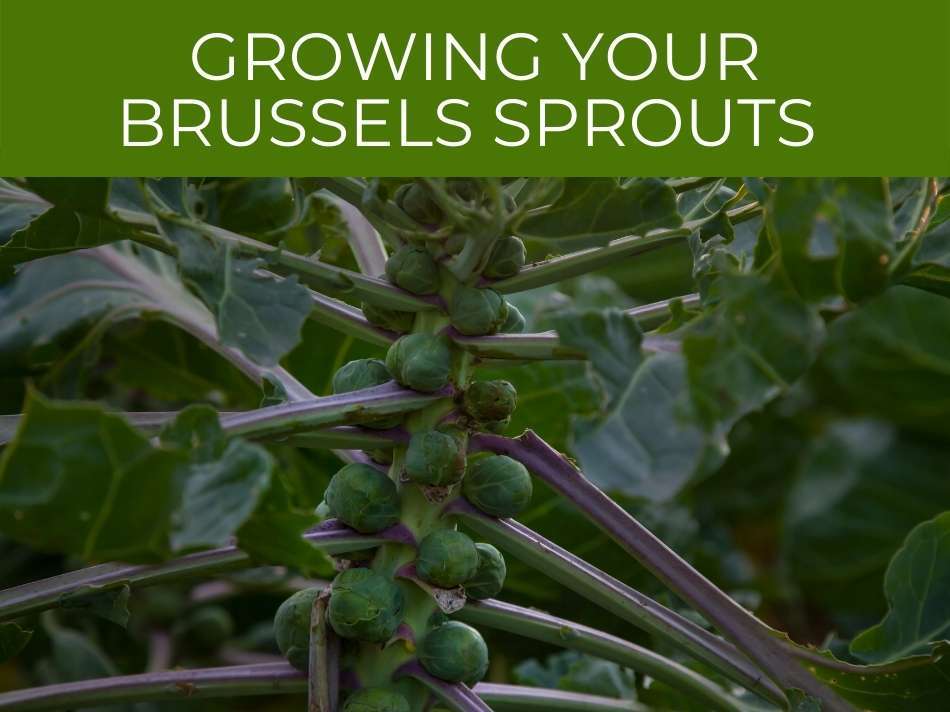
Growing Your Brussels Sprouts
Purchase some Brussels sprouts seeds in the variety of your choice, as well as a good nitrogen-heavy fertilizer. You will not use the fertilizer until later in the season. Keep it at hand anyway for convenience.
Depending on how warm it’s outside, start your Brussels sprouts indoors or outdoors. Your outdoor garden should receive five to seven hours of sunlight daily.
Once your seedlings sprout, they need to be three inches tall or have 7 strong leaves to be transplanted outdoors. Plant so they have adequate space within and between rows!
Generally, that distance should be about 25-30 inches apart in the row, with 25-30 inches between rows. This makes a neat and even square so that the leaves of your Brussels sprout plant can really stretch out and maintain productivity throughout the season.
Don’t forget that your variety of sprouts may have different requirements for planting distances. Some of the hybrids are smaller and don’t mind closer quarters with other plants. You may be able to plant them closer together, saving some space in the garden. Be sure to check the seed packet before planting your seedlings.
Water your seedlings frequently. Brussels sprouts are a cold weather vegetable and don’t take well to hot conditions. Keep them well mulched and well-watered.

Fertilizer
Brussels sprouts are a slow-maturing plant which usually takes the full season to grow. They require fertilizer as well to reach peak productivity and growth.
Fertilize the plant with a nitrogen fertilizer twice during the growing season. The first application should be done two to four weeks post-planting, and the second should be four weeks after the first application.

Harvesting
Wait to harvest until after the first frost occurs because it’ll improve their flavor, adding sweetness to the sprouts. If you’re unsure when, it’s simple and easy to check. Sprouts are mature when they are either green or purple, depending on your variety, and hard. They should be just smaller than a golf ball at about 1-2” in diameter.
When you are ready to harvest, you can either save time by chopping the plant off at the base of the stem with a sharp knife, or, twist off each sprout individually.
If you have a cool root cellar, try hanging or stacking the stalks inside. If you do so, it’s best to eat the sprouts within a few weeks.
Otherwise, twist off the sprouts from the main stalk and keep them in the fridge, where they’ll last for up to two weeks. Brussels sprouts are also freezable, which is a good idea if you have just harvested a bumper crop!
As for the leftover root system in the garden, you can leave it there. Brussels sprouts have shallow root systems, so it’ll be easy enough to remove any dead plant matter that remains in the garden once spring arrives.
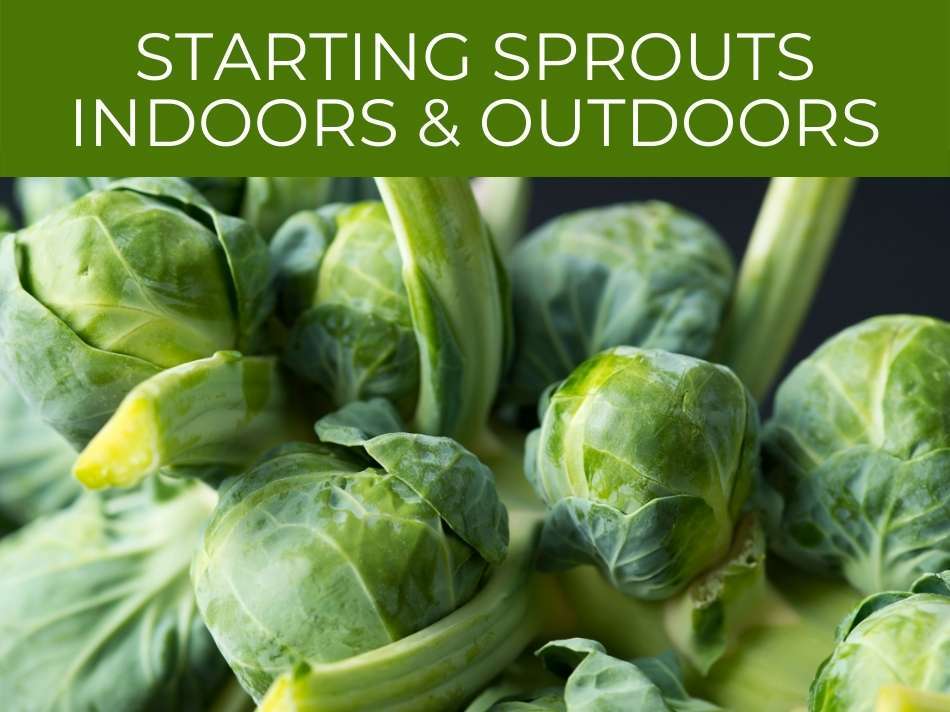
Starting sprouts indoors & outdoors
Brussels sprouts aren’t a common plant to find at your local hardware or garden store, so it’s likely that you’ll be growing them from seed. Research the conditions of your geographical area to see which method of sowing is right for you. Some varieties of sprouts do better with transplanting than others.
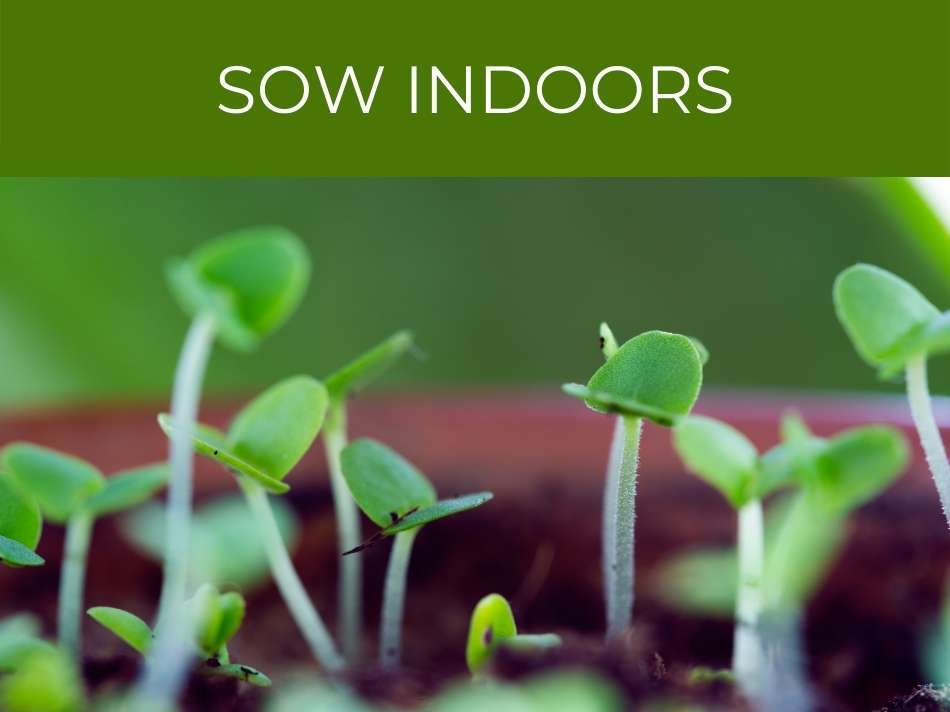
Sow indoors
Brussels sprouts require some planning. Start your seeds indoors about a month before you plan to transplant them outside.
Begin the planting process by setting up a seed tray filled with potting soil, peat moss, or whatever mix accompanies your kit.
If you would rather make a seed starting container yourself, use a shallow plastic dish, some popsicle sticks, and a large Ziploc-style bag that can fit over the dish. Add some good soil and some warm water until it’s humid and moist. Remember, it doesn’t have to look great – it just needs to make a hospitable environment for your sprouts.
Once you have your seed tray or homemade greenhouse, place a few seeds ¼ to ½ inch deep in each soil section. Water, maintain sunlight, moisture, and some TLC, and wait. If instructions come with your materials, be sure to follow them as well!
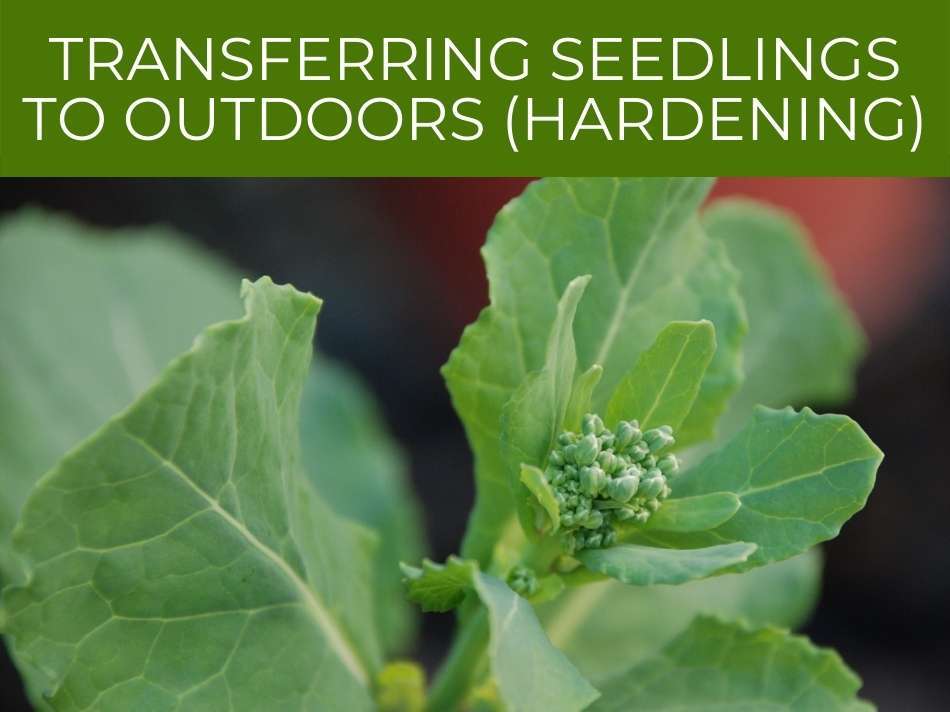
Transferring seedlings to outdoors (hardening)
Once your seedlings sprout, they need to either be three inches tall or have 7 strong leaves to be removed and transplanted outdoors. But, before transplanting them, these seedlings must be hardened to outdoor weather conditions.
Harden your seedlings by using a plastic tarp, a few stakes, and a watch. Over about a week, bring your seedlings outside into the sunlight and cover them with the tarp. Start off with a few hours outdoors, and slowly increase until they go out at dawn and come in at dusk. Healthy plants after this process are considered “weathered”, and you can plant them into your garden.
Look for an area in your garden that receives full sunlight – about 5 to 7 hours daily – and is available for the entirety of the growing season. While it’s best to allow the area to lie dormant for three to six months prior to planting, don’t worry if you just grew things there. Just ensure you have enough fertilizer.
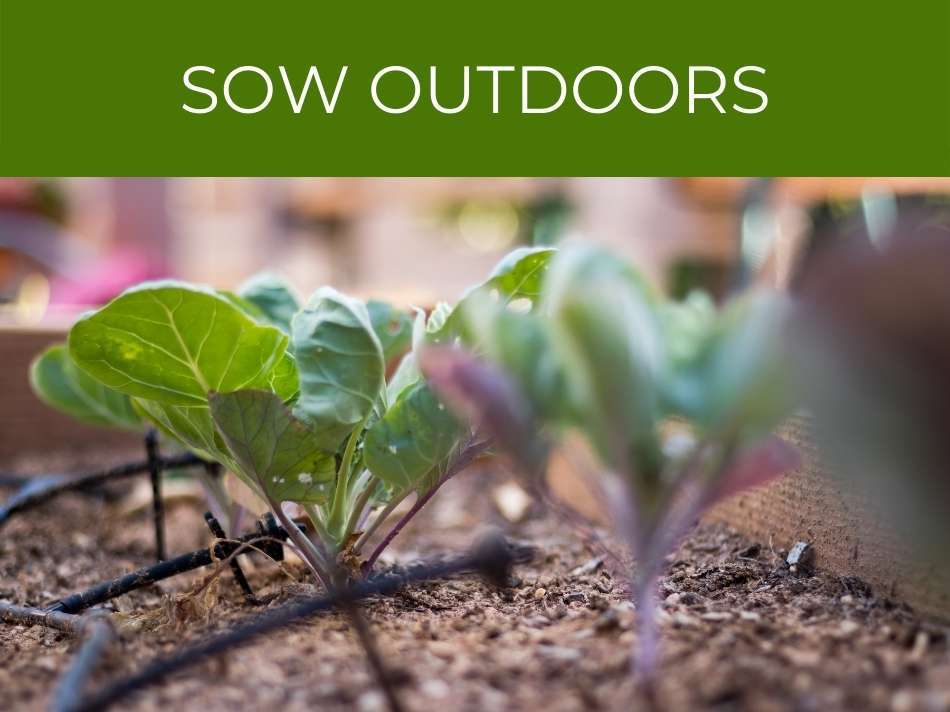
Sow outdoors
By sowing your Brussels sprouts outdoors, you will avoid the hassle of planting indoors and hardening your sprouts. However, sprouts sown outdoors can require up to three more weeks than indoor-sown sprouts to reach seedling size!
If you desire robust and productive seedlings, it really is best to use transplants, especially in colder northern climates.
However, if you do choose to sow your seeds outside, use a ground cover to prevent disturbance of the seeds. Once they sprout, thin to a point where there’s one seedling every 18 inches.
Make sure that the area is free of pests and animals that might eat young seedlings, has fertile soil, and is easily accessible so you can water it. Few things are worse than realizing the hose is ten feet short of the garden bed!
Brussels sprouts growing problems
Brussels sprouts aren’t just a tasty treat for humans – the rest of the plant and animal kingdom likes them too! Whether it’s bugs, mildew, or herbivores, they’ll be investigating the delicacies they find in your garden. Learn to spot signs of pests early and you’ll sidestep any potential issues with ease.
Problems
The taller your Brussels sprouts plant grows, the more sprouts it’ll produce, and the larger your harvest. That’s good news for us hungry gardeners. However, loftier Brussels sprouts plants are prone to wobbling and falling over because of their shallow root systems. Is there a way to increase the harvest size while ensuring that the plant doesn’t tip over? Yes!
Grab a stake and tie it to the main stem of the Brussels sprout plant. That will stabilize it and keep it going strong. Any further destabilization that appears unusual may be other problems like rotting or a weak plant, and you’ll want to assess your plant for pests or other issues.
Pests
Pests are, sadly, a perennial problem. While recent advancements in technology have allowed for some veggies to become totally pest-resistant, Brussels sprouts are not one of the lucky few, and can suffer from some problematic insects or mildew.
If you commonly experience pests, it may be best to grow a hybrid Brussels sprout to decrease your risk. Don’t worry, though, if you’ve got your heart set on an heirloom breed. There are easy ways to prevent and cure common issues and keep your Brussels sprouts going strong!
Powdery mildew
Powdery Mildew is a white fungus visible on the tops and bottoms of leaves. It capitalizes on low-humidity, dry conditions, and overuse of nitrogen fertilizer. If you water regularly, it shouldn’t be an issue, but more arid climates have higher potential to develop mildew issues.
To prevent powdery mildew, plant sprouts at least 11 inches apart, water consistently, and consider crop rotation. To stop already existing powdery mildew, try a sulfur spray.
Aphids
Cabbage aphids are easily removed with a powerful stream of water aimed directly at them. Turn your regular watering into a two-in-one task by checking for aphids when you water.
Cabbage Worms
Cabbage worms are a common problem among coles like Brussels sprouts, especially in fall crops. Apply Bacillus thuringiensis (Bt), which is a safe biological control. What’s great about Bt is that it’s both nontoxic and affordable.
To prevent cabbage worm destruction, apply Bt in a spray format to the leaves from the time they are transplanted or thinned until harvest.
Another thing you can do to prevent pest infestations is have proper irrigation. Keep the leaves dry and make sure you maintain optimal levels of moisture.
Herbivores
If you walk out to your garden in the morning and are greeted by the sight of bitten off stems and ragged leaves, you might have a rabbit or deer problem. This is a good opportunity to invest in a barricade or fence around your garden to keep unwanted animals out.
If you can identify the animal through tracks, scat, or sight (try the dawn or dusk), it’ll give you a good idea of what type of barrier to purchase.
Brussels sprouts are an intermediate size vegetable, so you can go either way on netting with stakes or a full fence. There are affordable methods for every gardener, and something simple like bamboo poles and netting won’t cost much at all.
Increasing Productivity & Harvesting
Everyone loves a larger harvest, right? Here is a great hack to increase the productivity of your Brussels sprout plant, and you can do it without much work at all.
Fifty to sixty days before the first frost, put your Brussels sprouts into a state of shock.
Shock them by removing the leaves on the stem from the base of the plant all the way up to about 4 inches short of the top. Make sure to leave the top two to three inches of leaves for photosynthesis.
The plant will go into ‘emergency mode’ and begin producing sprouts faster than ever. Unsure when exactly to do so? Use a weather app, farmer’s almanac, as well as days to harvest that should be displayed on your seed packet.
The good thing about shocking your sprouts is that they will be easier to monitor since the leaves around the base are gone. The sprouts practically grow before your eyes! One plant yields anywhere from 50 to 100 sprouts.
Don’t forget that the top of the plant, called the apical meristem, is also edible. Cut it off three weeks before harvesting. You can roast it in the same manner as you would the Brussels sprouts. Harvesting the top of the plant ensures that the sprouts mature completely on the stem.
Related Questions:
How long does it take to grow Brussels sprouts?
Brussels sprouts can take anywhere from 80 to over 110 days to grow from seed to harvest. They are a slow-growing vegetable, so it’s best to sow them in early spring, plant in late spring, and harvest throughout the fall.
How to grow Brussels sprouts from scraps?
It’s pretty fun to grow your own Brussels sprouts from a sprout you buy at the grocery store! Buy the freshest brussels sprouts you can find. The more well-formed the base of the sprout, the better. Use a clean plastic bottle with fresh water and nestle the sprout into the mouth of the bottle, making sure that the water touches the base of the sprout. Place your setup in a sunny window, and soon your sprout will have roots! You can go ahead and plant it in the ground once it has a substantial root mass.
Do Brussels sprouts come back every year?
The simple answer is no. Brussels sprouts are biennial plants, meaning they have a two-year life cycle, but because only the first year produces sprouts, gardeners uproot the plant at the end of the growing season, effectively making them annual vegetables.
When you plant Brussels sprouts, keep in mind that the plant does not return yearly, and you’ll need to plant seeds again the following year to have another crop.
Can you eat the leaves of the Brussels sprout plant?
Yes! Believe it or not, the miniature cabbage heads (sprouts) on the plant aren’t the only edible portion. The large leaves that shade the stalk and growing sprouts are edible too. However, aim for the smaller leaves at the top of the stalk, which will taste milder and have less exposure to the elements. Harvest it three weeks from when you’ll pick the sprouts.
Are there milder varieties of Brussels sprouts for picky eaters?
Possibly. In the last few centuries, Brussels sprouts haven’t been bred for picky eaters – they’ve been bred for higher yields. However, it’s very possible that some varieties have more or less of a bite than others.
First off, try traditional varieties, such as Early Half Tall, Bedford, and Noisette, which were bred for flavor, not for today’s modern yields. Try the Prince Marvel, which is sweeter than other varieties. Most of the flavor comes down not to the plant itself, but the cooking process. There are hundreds of ways to make your sprouts flavorful and delicious for even the pickiest of eaters!

